Variations of Rainfall Rhythm in Alto Pardo Watershed, Brazil: Analysis of Two Specific Years, a Wet and a Dry One, and Their Relation with the River Flow
Abstract
:1. Introduction
2. Materials and Methods
2.1. Study Area
2.2. Study Period, Data, and General Analysis
2.3. Spatial Interpolation of Rainfall
2.4. Rhythmic Analysis
- Air masses with tropical characteristics—Tropical Atlantic mass (mTA), Continentalized Tropical Atlantic mass (mTAC), and Tropical Continental mass (mTC); Air masses with polar characteristics—Polar Atlantic mass (mPA), Old Polar mass (mPV), and Continentalized Old Polar mass (mPVC); Air mass with equatorial characteristics—Equatorial Continental mass (mEQ).
- Frontal Systems—Polar Atlantic Front (FPA), Reflex Polar Front (FPR), Polar Atlantic Front in Dissipation (DIS), Repercussion of Polar Atlantic Front (REP), Stationary Polar Atlantic Front (EST), Warm Front (QTE), and Occlude Polar Atlantic Front (OCL).
- Individualized Systems—Tropical Instability Line (LI) and Atlantic Intertropical Convergence Zone (ZCIT).
- South Currents—mPA + mPV/PVC + FPA/DIS/EST + FPR.
- East Currents—mTA + TAC + Tropical Instability Line + QTE + REP.
- North Current—mEQ.
- West Current—mTC + Tropical Instability Line.
3. Results
3.1. General Analysis of Rainfall Variability
3.2. Spatial Analysis of Rainfall
3.3. Atmospheric Systems and Rhythmic Analysis
4. Discussion and Conclusions
Acknowledgments
Author Contributions
Conflicts of Interest
References
- Lima, K.C.; Satyamurty, P.; Fernández, J.P.R. Large-scale atmospheric conditions associated with heavy rainfall episodes in southeast brazil. Theor. Appl. Climatol. 2010, 101, 121–135. [Google Scholar] [CrossRef]
- Chi, X.; Yin, Z.; Wang, X.; Sun, Y. Spatiotemporal variations of precipitation extremes of China during the past 50 years (1960–2009). Theor. Appl. Climatol. 2015, 1–10. [Google Scholar] [CrossRef]
- Wollmann, C.A.; Sartori, M.G.B. Sazonalidade dos episódios de enchentes ocorridos na bacia hidrográfica do rio Caí—RS, e sua relação com a atuação do fenômeno El Niño, no período de 1982 a 2005. Rev. Bras. Climatol. 2009, 7, 103–118. [Google Scholar]
- Haddad, E.A.; Teixeira, E. Economic impacts of natural disasters in megacities: The case of floods in São Paulo, Brazil. Habitat Int. 2015, 45 Pt 2, 106–113. [Google Scholar] [CrossRef] [PubMed]
- Ebi, K.L.; Bowen, K. Extreme events as sources of health vulnerability: Drought as an example. Weather Clim. Extrem. 2016, 11, 95–102. [Google Scholar] [CrossRef]
- Coelho, C.A.S.; Cardoso, D.H.F.; Firpo, M.A.F. Precipitation diagnostics of an exceptionally dry event in São Paulo, Brazil. Theor. Appl. Climatol. 2016, 125, 769–784. [Google Scholar] [CrossRef]
- He, M.; Russo, M.; Anderson, M. Hydroclimatic Characteristics of the 2012–2015 California Drought from an Operational Perspective. Climate 2017, 5, 5. [Google Scholar] [CrossRef]
- Kunkel, K.E.; Pielke, R.A.; Changnon, S.A. Temporal fluctuations in weather and climate extremes that cause economic and human health impacts: A review. Bull. Am. Meteorol. Soc. 1999, 80, 1077–1098. [Google Scholar] [CrossRef]
- Easterling, D.R.; Evans, J.L.; Groisman, P.Y.; Karl, T.R.; Kunkel, K.E.; Ambenje, P. Observed variability and trends in extreme climate events: A brief review. Bull. Am. Meteorol. Soc. 2000, 81, 417–425. [Google Scholar] [CrossRef]
- Marengo, J.A.; Jones, R.; Alves, L.M.; Valverde, M.C. Future change of temperature and precipitation extremes in South America as derived from the PRECIS regional climate modeling system. Int. J. Climatol. 2009, 29, 2241–2255. [Google Scholar] [CrossRef]
- Intergovernmental Panel on Climate Change (IPCC). The Physical Science Basis. Contribution of Working Group to the Fifth Assessment Report of the Intergovernmental Panel on Climate Change; Cambridge University Press: New York, NY, USA, 2013. [Google Scholar]
- Sansigolo, C.A.; Kayano, M.T. Trends of seasonal maximum and minimum temperatures and precipitation in Southern Brazil for the 1913–2006 period. Theor. Appl. Climatol. 2010, 101, 209–216. [Google Scholar] [CrossRef]
- Jiang, F.; Hu, R.J.; Wang, S.P.; Zhang, Y.W.; Tong, L. Trends of precipitation extremes during 1960–2008 in Xinjiang, the Northwest China. Theor. Appl. Climatol. 2013, 111, 133–148. [Google Scholar] [CrossRef]
- Knapp, A.K.; Hoover, D.L.; Wilcox, K.R.; Avolio, M.L.; Koerner, S.E.; La Pierre, K.J.; Loik, M.E.; Luo, Y.; Sala, O.E.; Smith, M.D. Characterizing differences in precipitation regimes of extreme wet and dry years: Implications for climate change experiments. Glob. Chang. Biol. 2015, 21, 2624–2633. [Google Scholar] [CrossRef] [PubMed]
- Zandonadi, L.; Acquaotta, F.; Fratianni, S.; Zavattini, J.A. Changes in precipitation extremes in Brazil (Parana River Basin). Theor. Appl. Climatol. 2016, 123, 741–756. [Google Scholar] [CrossRef]
- Monteiro, C.A.F. Da necessidade de um caráter genético à classificação climática (algumas considerações metodológicas a propósito do estudo do Brasil Meridional). Rev. Geogr. 1962, 31, 29–44. [Google Scholar]
- Monteiro, C.A.F. A análise rítmica em climatologia: Problemas da atualidade climática em São Paulo e achegas para um programa de trabalho. Climatologia 1971, 1, 1–21. [Google Scholar]
- Sorre, M. Les Fondaments de la Géographie Humaine; Colin: Paris, France, 1950. [Google Scholar]
- Pédélaborde, P. Le Climat du Bassin Parisien: Essai d’une Méthode Rationelle de Climatologie Physique; Librairie de Medeces: Paris, France, 1957. [Google Scholar]
- Pédélaborde, P. Introduction a l’étude Scientifique du Clima; Centre de Documentation Cartographique: Paris, France, 1959. [Google Scholar]
- Pagney, P. Réflexions à propos d’ouvrages récents de Climatologie et de Météorologie. Rev. Geogr. l’Est. 1972, 12, 313–321. [Google Scholar] [CrossRef]
- Ribeiro, C.M. O desenvolvimento da climatologia dinâmica no Brasil. Rev. Geogr. Ens. 1982, 1, 48–59. [Google Scholar]
- Boin, M.N. Chuvas e Erosões no Oeste Paulista: Uma Análise Climatológica Aplicada. Ph.D. Thesis, Sao Paulo State University, Rio Claro, Brazil, 2000. [Google Scholar]
- Barros, J.R. A Chuva No Distrito Federal : O Regime E As Excepcionalidades Do Ritmo. Ph.D. Thesis, Sao Paulo State University, Rio Claro, Brazil, 2003. [Google Scholar]
- Ely, D. Teoria e Método da Climatologia Geografica Brasilera: Uma Abordagem Sobre Seus Discursos e Prácticas. Ph.D. Thesis, Sao Paulo State University, Presidente Prudente, Brazil, 2006. [Google Scholar]
- Zavattini, J.A. As Chuvas e as Massas de ar no Estado de Mato Grosso do Sul: Estudos Geográficos com Vista à Regionalização Climática; Cultura Acadêmica: São Paulo, Brazil, 2009; pp. 1–214. [Google Scholar]
- Ribeiro, A.A. Eventos Pluviais Extremos e Estiagens na Região das Missões, RS: A Percepção dos Moradores no Município de Santo Antônio das Missões. Master’s Thesis, Sao Paulo State University, Rio Claro, Brazil, 2012. [Google Scholar]
- Monteiro, C.A.F.; Mendonça, F.A.; Zavattini, J.A.; Sant’Anna Neto, J.L.S. The Construction of Geographical Climatology in Brazil; Alínea: Campinas, Brazil, 2015; pp. 1–170. [Google Scholar]
- Zavattini, J.A. Pluies Intenses et Inondations dans la Vallée du Fleuve Itajaí (Région de Santa Catarina), Brésil. Geogr. Tech. 2009, 1, 477–482. [Google Scholar]
- Fratianni, S.; Zavattini, J.A. Il Contributo della Climatologia Dinamica all’analisi nivometrica e risvolti turistici in Val di Susa. Mem. Della Soc. Geogr. Ital. 2009, 87, 319–332. [Google Scholar]
- Zavattini, J.A.; Fratianni, S. Variações do ritmo climático no piemonte italiano: Reflexos no Vale de Susa (neve e turismo) e no ‘terroir’ do barolo (produção vitivinícola). Rev. Geogr. 2016, 33, 35–63. [Google Scholar]
- Douguedroit, A. Quelle «exception française» en matière de «types de temps»? Norois Environ. Aménagement Soc. 2004, 33–39. [Google Scholar] [CrossRef]
- Baur, F. Einführung in die Großwetterkunde; Dieterich: Wiesbaden, Germany, 1948. [Google Scholar]
- Hess, P.; Brezowsky, H. Katalog der Grobwetterlagen Europas (1881–1976); Berichte des Deutschen Wetterdienstes in der US-Zone: Offenbach, Germany, 1952. [Google Scholar]
- Lamb, H.H. Types and spells of weather around the year in the British Isles: Annual trends, seasonal structure of the year, singularities. Q. J. R. Meteorol. Soc. 1950, 76, 393–429. [Google Scholar] [CrossRef]
- Sheridan, S.C. The redevelopment of a weather-type classification scheme for North America. Int. J. Climatol. 2002, 22, 51–68. [Google Scholar] [CrossRef]
- Armond, N.B. Entre Eventos e Episódios: As Excepcionalidades das Chuvas e os Alagamentos no Espaço Urbano do Rio de Janeiro. Master’s Thesis, Sao Paulo State University, Presidente Prudente, Brazil, 2014. [Google Scholar]
- Carrega, P. Avant-propos sur les «types de temps». Norois Environ. Aménagement Soc. 2004, 7–9. [Google Scholar] [CrossRef]
- Vigneau, J.-P. Un siècle de «type de temps». Epistémologie d’un concept ambigu. Norois Environ. Aménagement Soc. 2004, 11–13. [Google Scholar] [CrossRef]
- Nimer, E. Climatologia do Brasil, 4th ed.; Supren/Ibge: Rio de Janeiro, Brazil, 1979. [Google Scholar]
- Fontão, P.A.B. Ritmo das Chuvas na Bacia do Pardo (SP/MG): Reflexos na Vazão dos rios Pardo e Mogi-Guaçu. Master’s Thesis, Sao Paulo State University, Rio Claro, Brazil, 2014. [Google Scholar]
- Fontão, P.A.B.; Zavattini, J.A. Regionalização das chuvas anuais na Bacia do Pardo, Brasil. Cad. Prud. Geogr. 2014, Especial, 143–158. [Google Scholar]
- Operador Nacional do Sistema Elétrico (ONS). Plano Anual de Prevenção de Cheias Ciclo 2016/2017; Operador Nacional do Sistema Elétrico: Rio de Janeiro, Brazil, 2016; pp. 1–149. [Google Scholar]
- Cia Pesquisa Recursos Minerais (CPRM). Atlas Geoambiental das Bacias Hidrográficas dos Rios Mogi Guaçu e Pardo—SP: Subsídios Para o Planejamento Territorial e Gestão Ambiental; CPRM: São Paulo, Brazil, 2002; p. 77. [Google Scholar]
- Fontão, P.A.B.; Zavattini, J.A. As chuvas na Bacia do Pardo: Procedimentos para a escolha de ‘anos-padrão’. In XI Simpósio Brasileiro de Climatologia Geográfica, Curitiba—PR, Brazil, 2014; ABClima: Curitiba, Brazil, 2014; pp. 1989–2000. [Google Scholar]
- Zandonadi, L. As Chuvas na Bacia do Paraná: Aspectos Temporais, Espaciais e Rítmicos. Master’s Thesis, Sao Paulo State University, Rio Claro, Brazil, 2009. [Google Scholar]
- National Weather Service. El Niño—Southern Oscillation (ENSO). Available online: http://www.cpc.ncep.noaa.gov/products/precip/CWlink/MJO/enso.shtml (accessed on 2 February 2017).
- Grimm, A.M.; Aceituno, P. El niño, novamente! Rev. Bras. Meteorol. 2015, 30, 351–357. [Google Scholar] [CrossRef]
- DAEE. Banco de Dados Hidrológicos. Available online: http://www.hidrologia.daee.sp.gov.br/ (accessed on 10 October 2016).
- Operador Nacional do Sistema Elétrico (ONS). Séries de Vazão. Available online: http://www.ons.org.br/operacao/vazoes_naturais.aspx (accessed on 10 October 2016).
- Operador Nacional do Sistema Elétrico (ONS). Atualização De Séries Históricas De Vazões—Período 1931 a 2015; Operador Nacional do Sistema Elétrico: Rio de Janeiro, Brazil, 2016. [Google Scholar]
- Tucci, C.E.M. Hidrologia: Ciência e Aplicação, 4th ed.; ABRH-EPUSP: Porto Alegre, Brazil, 2013. [Google Scholar]
- Tabios, G.Q.; Salas, J.D. A comparative analysis of techniques for spatial interpolation of precipitation. J. Am. Water Resour. Assoc. 1985, 21, 365–380. [Google Scholar] [CrossRef]
- Zavattini, J.A. Estudos do Clima No Brasil; Alínea: Campinas, Brazil, 2004. [Google Scholar]
- Neves, G.; Gallardo, N.; Vecchia, F. A Short Critical History on the Development of Meteorology and Climatology. Climate 2017, 5, 23. [Google Scholar] [CrossRef]
- Knapp, K.R. Scientific data stewardship of International Satellite Cloud Climatology Project B1 global geostationary observations. J. Appl. Remote Sens. 2008, 2, 023548. [Google Scholar] [CrossRef]
- Marinha do Brasil. Centro de Hidrografia da Marinha. Available online: http://www.mar.mil.br/dhn/chm/meteo/prev/cartas/cartas (accessed on 15 October 2016).
- Huth, R.; Beck, C.; Philipp, A.; Demuzere, M.; Ustrnul, Z.; Cahynová, M.; Kyselý, J.; Tveito, O.E. Classifications of atmospheric circulation patterns: Recent advances and applications. Ann. N. Y. Acad. Sci. 2008, 1146, 105–152. [Google Scholar] [CrossRef] [PubMed]
- Yarnal, B.; Comrie, A.C.; Frakes, B.; Brown, D.P. Developments and prospects in synoptic climatology. Int. J. Climatol. 2001, 21, 1923–1950. [Google Scholar] [CrossRef]
- Lewis, A.B.; Keim, B.D. History and Applications of Manual Synoptic Classification. Ref. Mod. Earth Syst. Environ. Sci. 2015, 1–7. [Google Scholar] [CrossRef]
- Lee, C.C.; Sheridan, S.C. Synoptic Climatology: An Overview. Ref. Mod. Earth Syst. Environ. Sci. 2015, 1–7. [Google Scholar] [CrossRef]
- Serra, A.; Ratisbona, L. As Massas de ar da América do Sul; Ministério da Agricultura, Serviço de Meteorologia: Rio de Janeiro, Brazil, 1942.
- Monteiro, C.A.F. Sobre Um Índice de Participação das Massas de Ar e suas Possibilidades de Aplicação à Classificação Climática. Rev. Geogr. 1964, 33, 59–69. [Google Scholar]
- Mendonça, F. La connaissance du climat au brésil: Entre le vernaculaire et le scientifique. Confin. Rev. Fr. Brésilienne Géogr. Rev. Fr. Bras. Geogr. 2012. [Google Scholar] [CrossRef]
- Zavattini, J.A.; Boin, M.N. Climatologia Geográfica: Teoria e Prática de Pesquisa; Alínea: Campinas, Brazil, 2013. [Google Scholar]
- Ogashawara, I.; Zavattini, J.A.; Tundisi, J.G. The climatic rhythm and blooms of cyanobacteria in a tropical reservoir in São Paulo, Brazil. Braz. J. Biol. 2014, 74, 72–78. [Google Scholar] [CrossRef] [PubMed]
- Mendonça, F.; Danni-Oliveira, I.M. Climatologia: Noções Básicas e Climas do Brasil; Oficina de Textos: São Paulo, Brazil, 2007. [Google Scholar]
- Wilhite, D.A. Drought as a natural hazard: concepts and definitions. In Drought: A Global Assessment; Routledge: London, UK, 2000; pp. 3–18. [Google Scholar]
- Monteiro, C.A.F. A Frente Polar Atlântica e as Chuvas de Inverno na Fachada Sul-Oriental do Brasil (Contribuição Metodológica à Análise Rítmica dos Tipos de Tempo no Brasil); USP/IG: São Paulo, Brazil, 1969. [Google Scholar]
- Tarifa, J.R. Fluxos Polares e as Chuvas de Primavera-Verão no Estado de São Paulo; Doctoral Dregree-USP: São Paulo, Brazil, 1975. [Google Scholar]
- Strahler, A.H. Physical Geography; John Wiley & Sons: New York, NY, USA, 1951. [Google Scholar]
- Monteiro, C.A.F. A Dinâmica Climática e as Chuvas no Estado de São Paulo: Estudo Geográfico sob a Forma de Atlas; USP/Igeog: São Paulo, Brazil, 1973. [Google Scholar]
- Monteiro, C.A.F. A Dinâmica Climática e as Chuvas no Estado de São Paulo; UNESP/Ageteo: Rio Claro, Brazil, 2000. [Google Scholar]
- Nery, J.T. Dinâmica climática da região sul do Brasil. Rev. Bras. Climatol. 2005, 1, 61–75. [Google Scholar]
- Carvalho, L.M.V.; Jones, C.; Liebmann, B. The South Atlantic Convergence Zone: Persistence, intensity, form, extreme precipitation and relationships with intraseasonal activity. J. Clim. 2004, 17, 88–108. [Google Scholar] [CrossRef]
- Coelho, C.A.; de Oliveira, C.P.; Ambrizzi, T.; Reboita, M.S.; Carpenedo, C.B.; Campos, J.L.P.S.; Tomaziello, A.C.N.; Pampuch, L.A.; de Souza Custódio, M.; Dutra, L.M.M. The 2014 southeast Brazil austral summer drought: Regional scale mechanisms and teleconnections. Clim. Dyn. 2016, 46, 3737–3752. [Google Scholar] [CrossRef]
- Monteiro, C.A.F. Clima e Excepcionalismo: Conjecturas Sobre o Desempenho da Atmosfera Como Fenômeno Geográfico; UFSC: Florianópolis, Brazil, 1991. [Google Scholar]
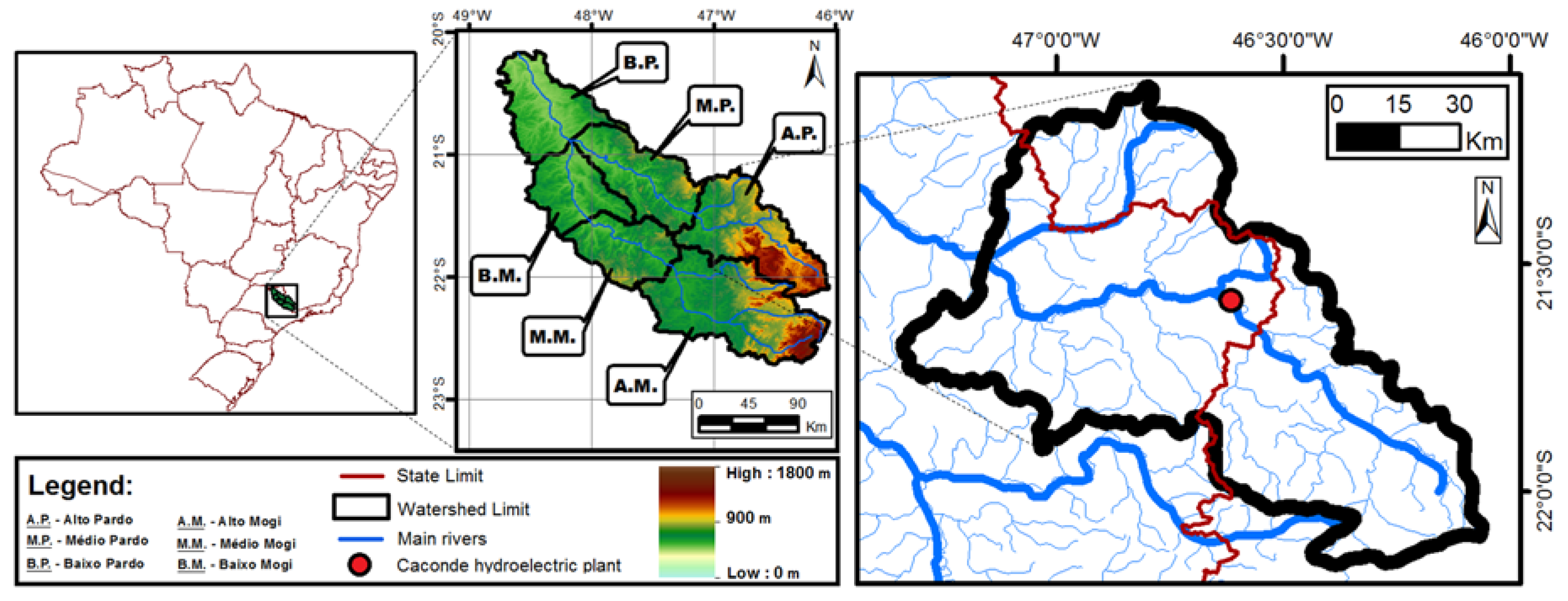
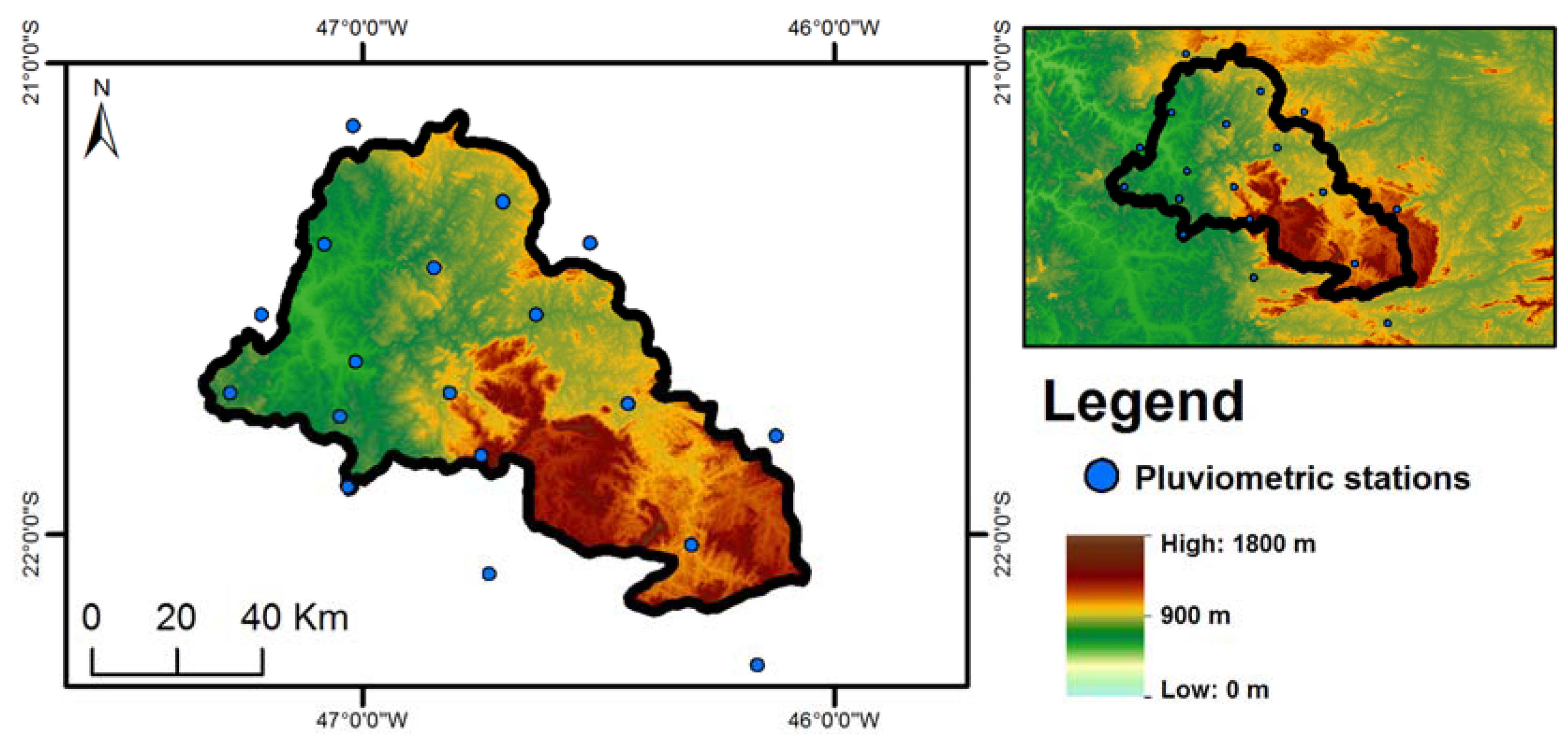
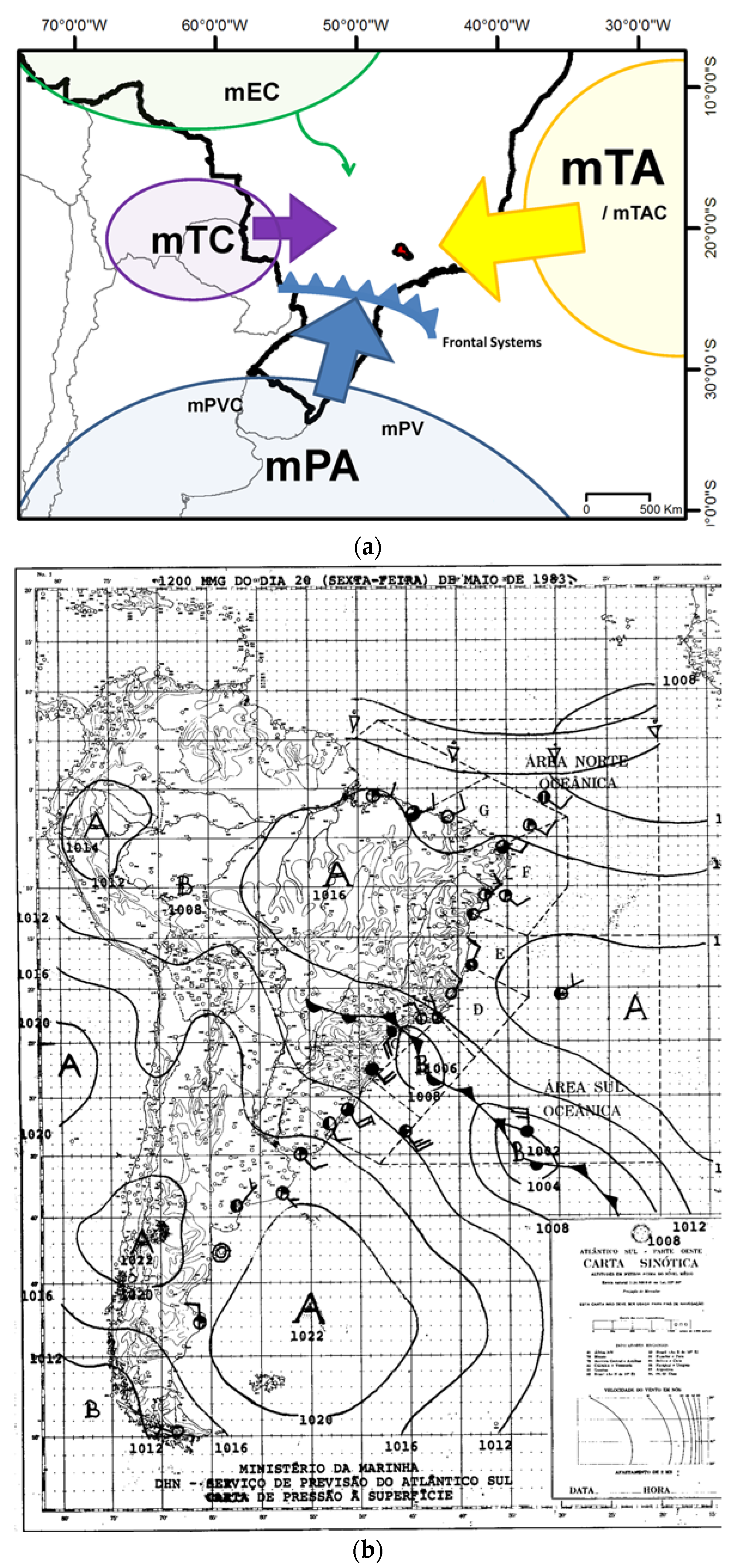
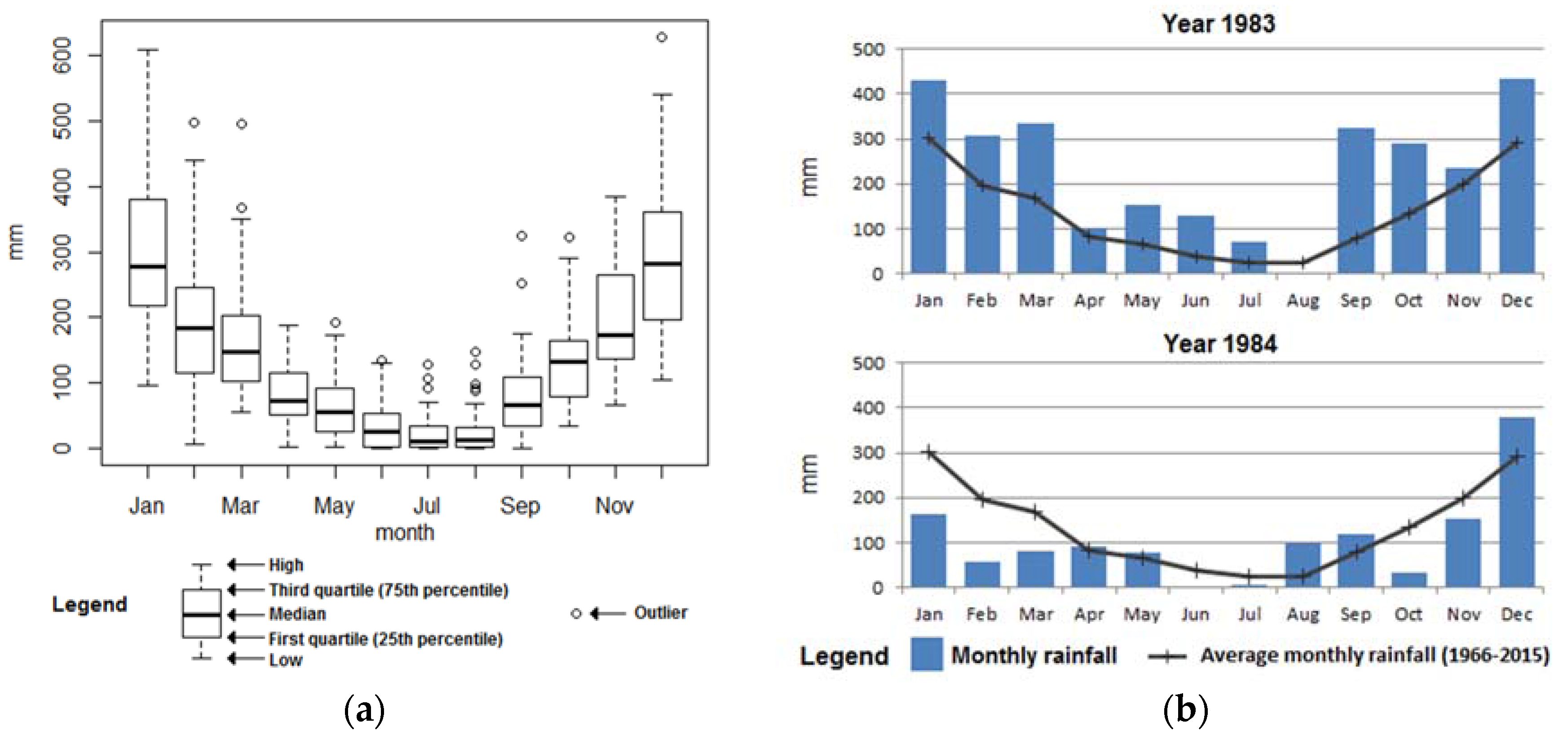
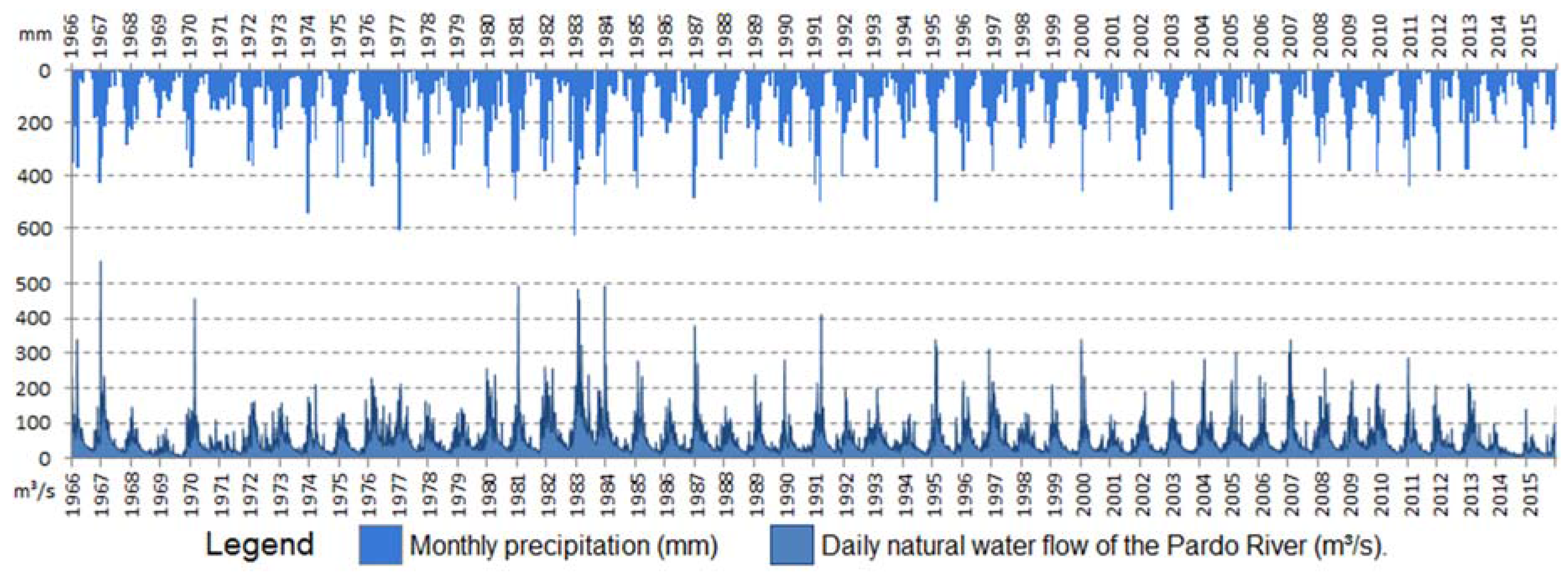
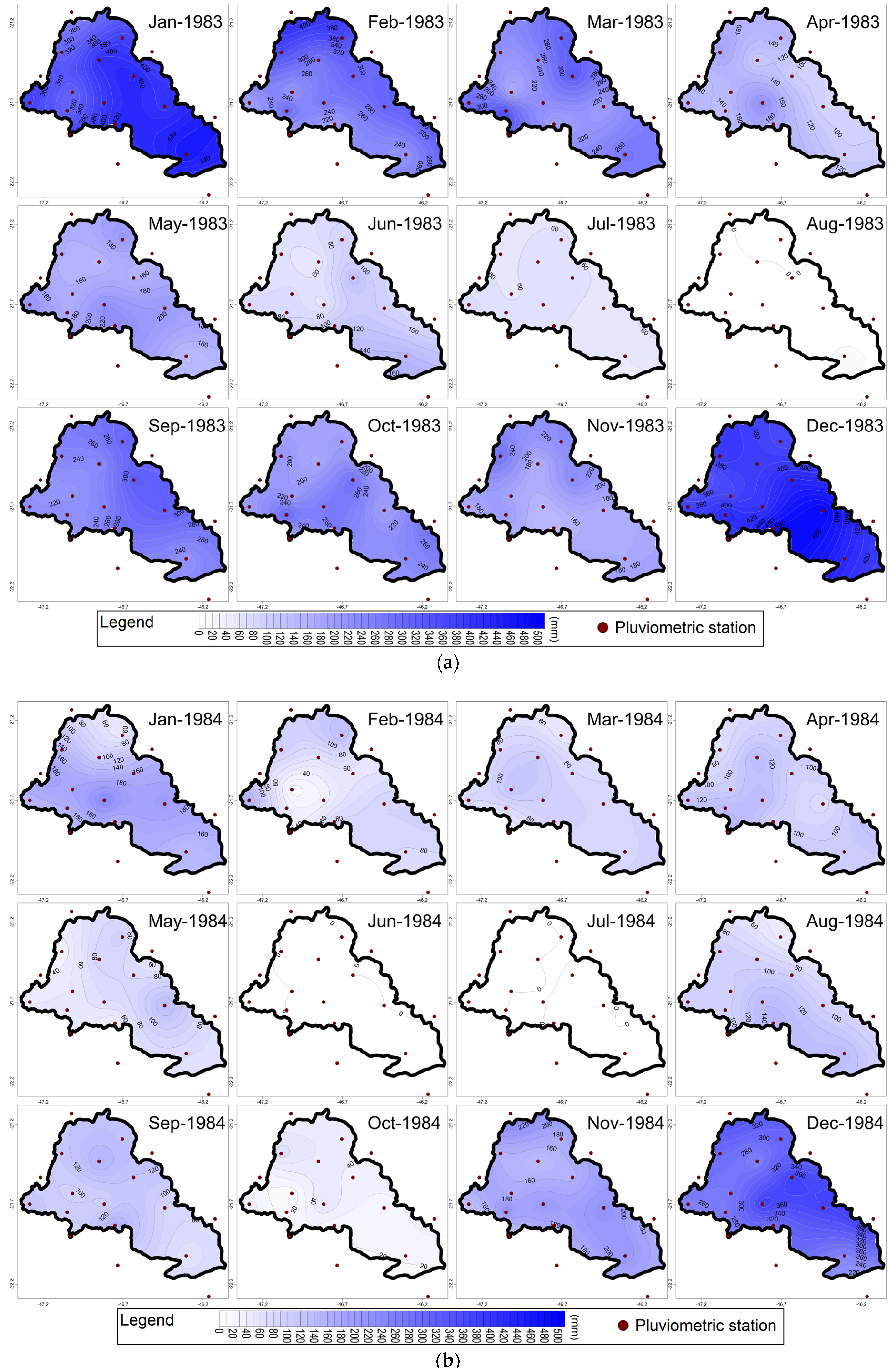
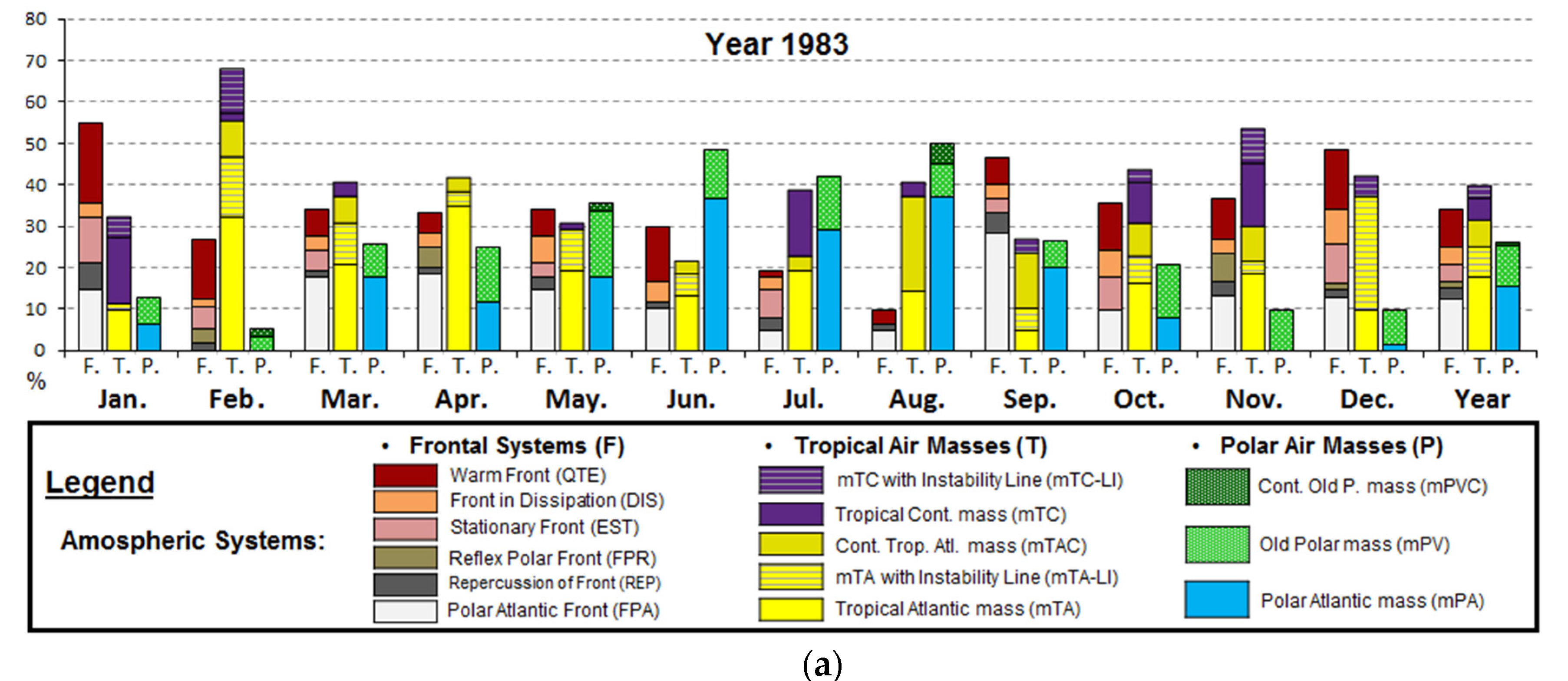
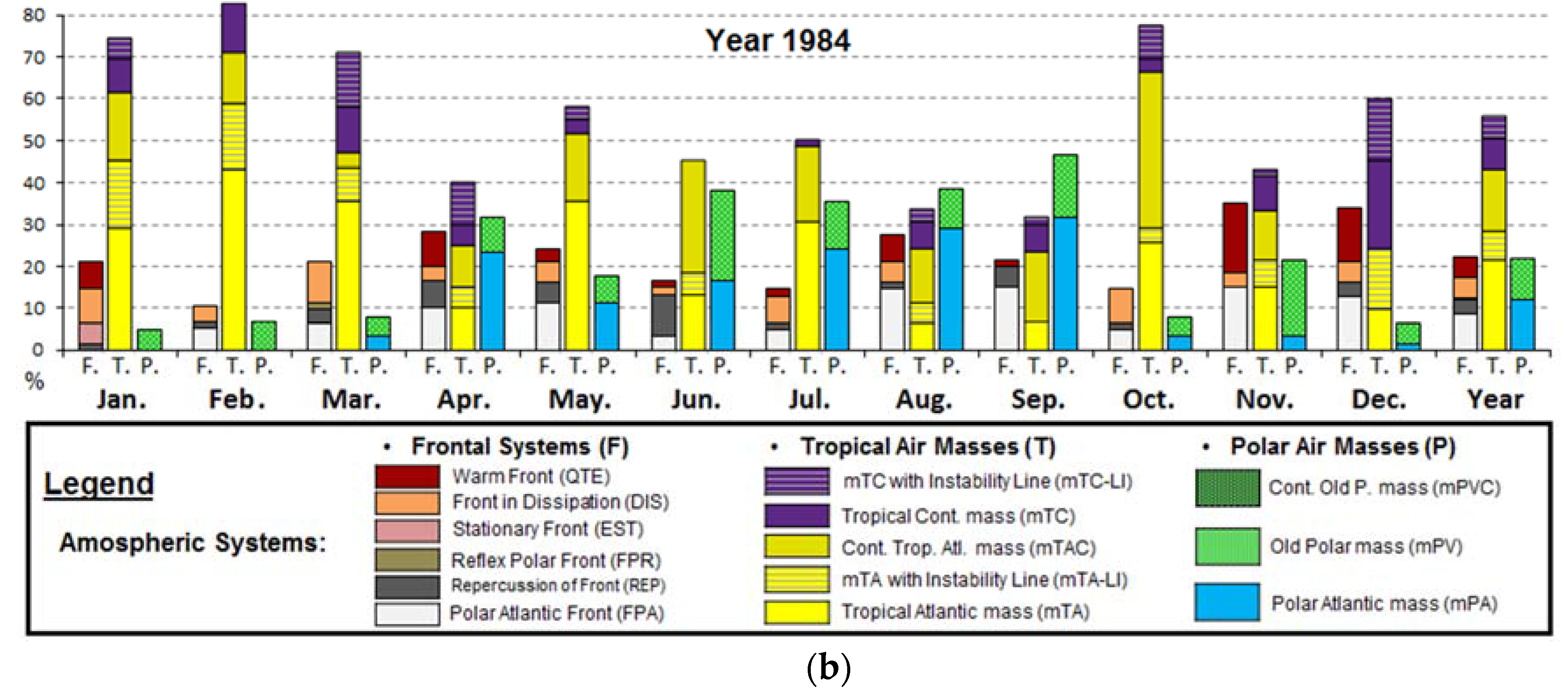
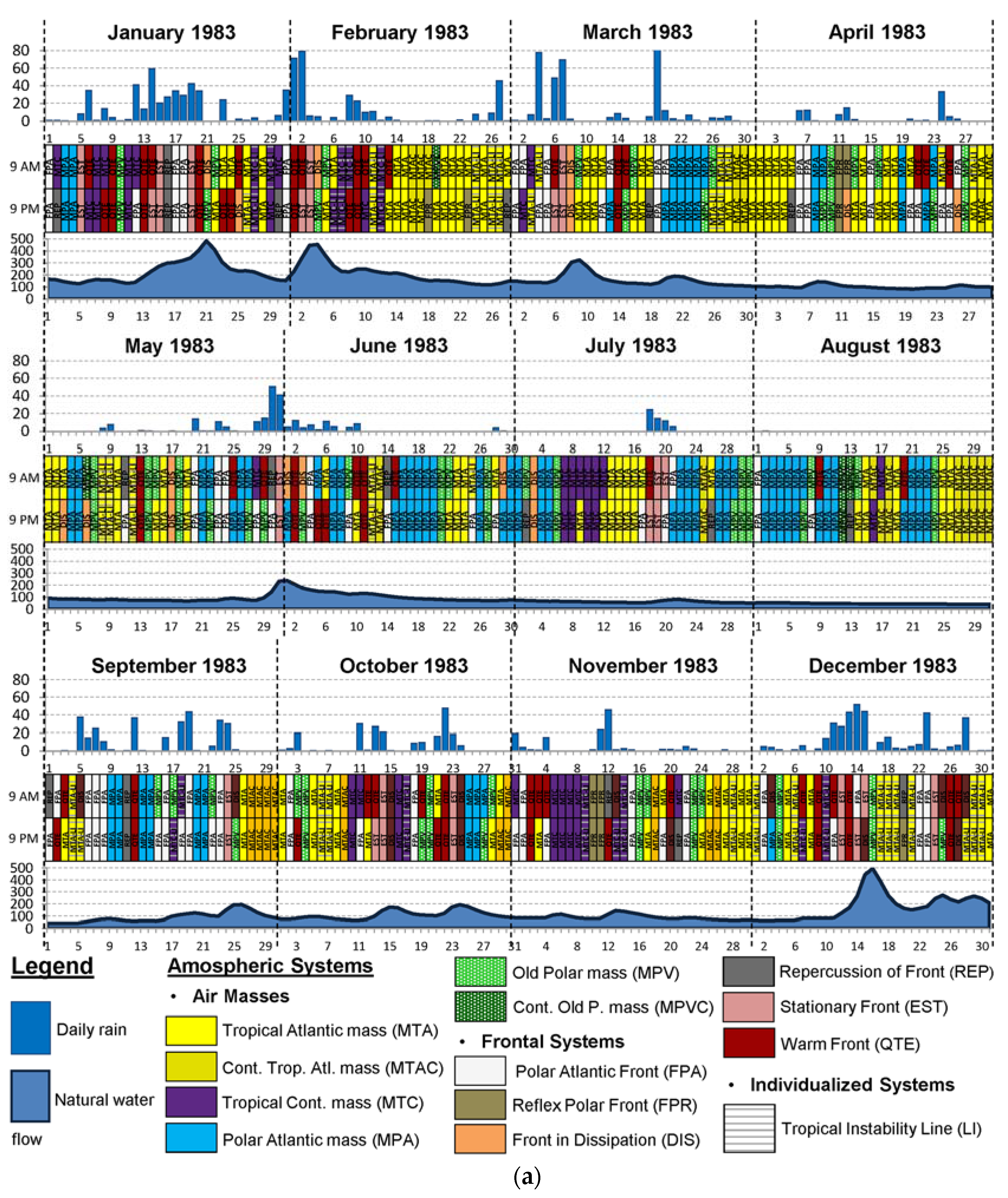
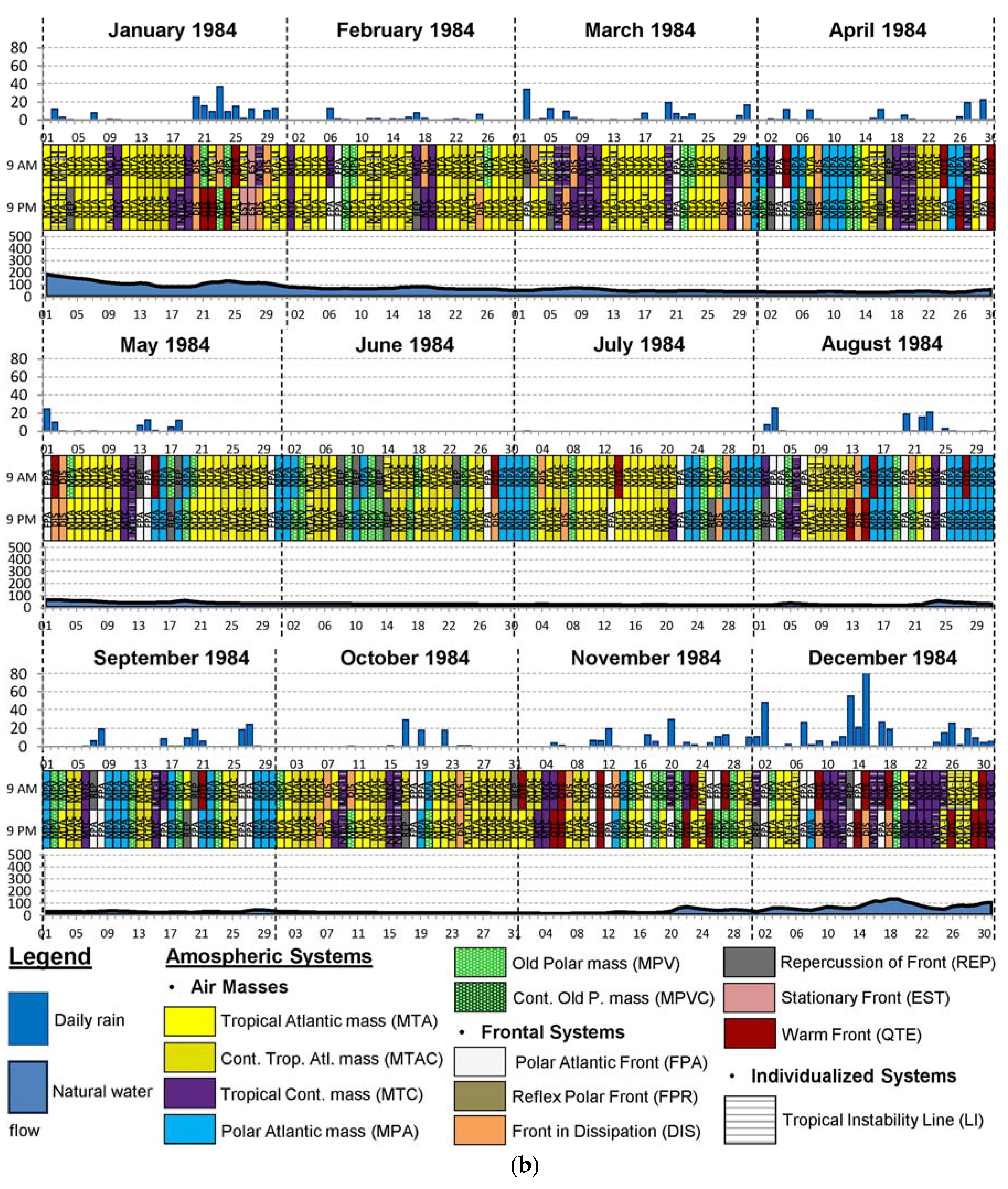
| Pluviometric Station 1 | Latitude (S) | Longitude (W) | Elevation (m) | |
|---|---|---|---|---|
| 1 | Fazenda Carvalhais | −21.13 | −47.02 | 873 |
| 2 | Guaxupé | −21.29 | −46.70 | 828 |
| 3 | Muzambinho | −21.38 | −46.52 | 1040 |
| 4 | Sítio Esplanada | −21.38 | −47.08 | 660 |
| 5 | Fazenda Açude | −21.43 | −46.85 | 840 |
| 6 | Fazenda Morrinhos | −21.53 | −47.22 | 610 |
| 7 | Caconde | −21.53 | −46.63 | 880 |
| 8 | Usina Limoeiro | −21.63 | −47.02 | 580 |
| 9 | Tambau | −21.70 | −47.28 | 730 |
| 10 | São Sebastião da Grama | −21.70 | −46.82 | 920 |
| 11 | Cachoeira do Carmo | −21.72 | −46.44 | 875 |
| 12 | Casa Branca | −21.75 | −47.05 | 670 |
| 13 | Cacheira Poço Fundo | −21.79 | −46.12 | 820 |
| 14 | São Roque da Fartura | −21.83 | −46.75 | 1310 |
| 15 | Lagoa Branca | −21.90 | −47.03 | 700 |
| 16 | Beira de Santa Rita | −22.02 | −46.30 | 1140 |
| 17 | Fazenda Paraíso | −22.08 | −46.73 | 810 |
| 18 | Borda da Mata | −22.28 | −46.16 | 854 |
| Type | Origin | Criteria for Classification 1 |
|---|---|---|
| mTA | South Atlantic Anticyclone high-pressure system over tropical latitudes, presenting high temperature and humidity characteristics. | The presence of isobars of the high pressure sector influencing the study area, through the air flows of east and northeast observed in the synoptic chart, reinforced by the tropical characteristics of the climatic variables, such as high temperatures and relative humidity. |
| mTAC | This system is formed from the mTA, when it remains over the continent for a few days and although it still has a high pressure, it loses its original properties, mainly decreasing the relative humidity. | Always preceded by mTA and presenting a pressure pattern similar to this air mass, it is distinguished by the significant change in the climatic variables that can be observed in the data of the study area, such as the great decrease in relative humidity, higher maximum temperature, clear sky, and high insolation. |
| mTC | Low pressure system of Chaco, in the Tropic region east of the Andes, with cyclonic circulation of the surface and anticyclonic at the upper levels, as a consequence of the intermittent thermal-orographic depression. The characteristics of this air mass is hot and dry. | The presence of isobars of the low pressure sector of the center of South America in the study area, coming from the air flows to the west observed in the synoptic chart. A large decrease in relative humidity, elevation of maximum temperature, clear sky, and high insolation are characteristics of this air mass. |
| mPA | Anticyclone with the source region in the Atlantic Ocean in southern South America, presenting cold temperatures as the main characteristic. Because of the high pressure, this air mass tends to flow towards the lower latitudes. | It always occurs after the passage of a cold front, when the incursion of this anticyclonic system happens. In addition to observing the high pressure influencing the region in the synoptic charts, another factor that should be noted is the weather data, mainly the presence of lower temperatures and high atmospheric pressure for the area. |
| mPV | This system is formed from the mPA, when it remains outside the source region for a few days and loses its original properties, mainly raising its temperature. | In the synoptic chart one must observe the incursion and the influence of the polar anticyclone on the study area. However, it differs clearly from mPA by the sensible decrease of the original atmospheric pressure, in addition to the higher temperature when acquiring the tropical characteristics. |
| mPVC | Similar to mPV, this system is formed from mPA when it loses its original properties; however, it was modified by the continental trajectory of the anticyclone migration, mainly decreasing the relative humidity. | It presents the same criteria of mPV, however it is classified as mPVC when the anticyclone trajectory occurs inside the continent, resulting in very low relative humidity. |
| Type | Criteria for Classification 1 |
|---|---|
| FPA | The system is represented in the synoptic chart as the limits of mPA’s advance toward the study area. A drop in temperature and atmospheric pressure should be noted in the climatic variables, in addition to an increase in the relative humidity and cloudiness. |
| FPR | This system occurs when, after the polar air has advanced over the region of study, a trough is observed in this anticyclone forming a squall line, which can be identified in the synoptic chart by the symbol of frontolysis in the continent and the symbol of frontogenesis in the ocean. Increased humidity and cloudiness can be observed in the climate data. |
| DIS | It is represented in the synoptic chart as a frontolysis over the study area. In the climatic variables, an increase of the sunshine and decrease of the humidity and cloudiness can be observed during the day. |
| REP | This system is classified when an approximation of the FPA is observed through the synoptic chart, but it does not occur directly over the study area. Even so, a significant change has already been observed in the climatic variables such as increased cloudiness and humidity, decreased thermal amplitude and, in most cases, precipitation. |
| EST | This system has a specific symbol for stationary front in the synoptic chart, and can be classified when a frontal system is moving very slowly or is stalled for a few days. Mostly cloudiness and precipitation are observed. |
| QTE | This system can be identified as a warm front in the synoptic chart. It is usually associated with increased cloudiness and temperature, and the occurrence of precipitation. |
| LI | Lines of instability may appear on air masses, especially mTA and mTC, identified in the synoptic chart as a trough line. These lines of pressure intensify the convective movement. Rainfall and increase of the humidity can usually be observed. |
| Atmospheric System (%) | Months—1983 | Year | |||||||||||
|---|---|---|---|---|---|---|---|---|---|---|---|---|---|
| Jan. | Feb. | Mar. | Apr. | May | Jun. | Jul. | Aug. | Sep. | Oct. | Nov. | Dec. | ||
| FPA | 14.5 | 0.0 | 17.7 | 18.3 | 14.5 | 10.0 | 4.8 | 4.8 | 28.3 | 9.7 | 13.3 | 12.9 | 12.5 |
| REP | 6.5 | 1.8 | 1.6 | 1.7 | 3.2 | 1.7 | 3.2 | 1.6 | 5.0 | 0.0 | 3.3 | 1.6 | 2.6 |
| FPR | 0.0 | 3.6 | 0.0 | 5.0 | 0.0 | 0.0 | 0.0 | 0.0 | 0.0 | 0.0 | 6.7 | 1.6 | 1.4 |
| EST | 11.3 | 5.4 | 4.8 | 0.0 | 3.2 | 0.0 | 6.5 | 0.0 | 3.3 | 8.1 | 0.0 | 9.7 | 4.4 |
| DIS | 3.2 | 1.8 | 3.2 | 3.3 | 6.5 | 5.0 | 3.2 | 0.0 | 3.3 | 6.5 | 3.3 | 8.1 | 4.0 |
| QTE | 19.4 | 14.3 | 6.5 | 5.0 | 6.5 | 13.3 | 1.6 | 3.2 | 6.7 | 11.3 | 10.0 | 14.5 | 9.3 |
| MTA | 9.7 | 32.1 | 21.0 | 35.0 | 19.4 | 13.3 | 19.4 | 14.5 | 5.0 | 16.1 | 18.3 | 9.7 | 17.7 |
| MTA-LI | 1.6 | 14.3 | 9.7 | 3.3 | 9.7 | 5.0 | 0.0 | 0.0 | 5.0 | 6.5 | 3.3 | 27.4 | 7.1 |
| MTAC | 0.0 | 8.9 | 6.5 | 3.3 | 0.0 | 3.3 | 3.2 | 22.6 | 13.3 | 8.1 | 8.3 | 0.0 | 6.4 |
| MTC | 16.1 | 1.8 | 3.2 | 0.0 | 1.6 | 0.0 | 16.1 | 3.2 | 0.0 | 9.7 | 15.0 | 0.0 | 5.6 |
| MTC-LI | 4.8 | 10.7 | 0.0 | 0.0 | 0.0 | 0.0 | 0.0 | 0.0 | 3.3 | 3.2 | 8.3 | 4.8 | 2.9 |
| MPA | 6.5 | 0.0 | 17.7 | 11.7 | 17.7 | 36.7 | 29.0 | 37.1 | 20.0 | 8.1 | 0.0 | 1.6 | 15.6 |
| MPV | 6.5 | 3.6 | 8.1 | 13.3 | 16.1 | 11.7 | 12.9 | 8.1 | 6.7 | 12.9 | 10.0 | 8.1 | 9.9 |
| MPVC | 0.0 | 1.8 | 0.0 | 0.0 | 1.6 | 0.0 | 0.0 | 4.8 | 0.0 | 0.0 | 0.0 | 0.0 | 0.7 |
| Frontal Systems | 54.8 | 26.8 | 33.9 | 33.3 | 33.9 | 30.0 | 19.4 | 9.7 | 46.7 | 35.5 | 36.7 | 48.4 | 34.1 |
| Tropical Masses | 32.3 | 67.9 | 40.3 | 41.7 | 30.6 | 21.7 | 38.7 | 40.3 | 26.7 | 43.5 | 53.3 | 41.9 | 39.7 |
| Polar Masses | 12.9 | 5.4 | 25.8 | 25.0 | 35.5 | 48.3 | 41.9 | 50.0 | 26.7 | 21.0 | 10.0 | 9.7 | 26.2 |
| Atmospheric System (%) | Months—1984 | Year | |||||||||||
|---|---|---|---|---|---|---|---|---|---|---|---|---|---|
| Jan. | Feb. | Mar. | Apr. | May | Jun. | Jul. | Aug. | Sep. | Oct. | Nov. | Dec. | ||
| FPA | 0.0 | 5.2 | 6.5 | 10.0 | 11.3 | 3.3 | 4.8 | 14.5 | 15.0 | 4.8 | 15.0 | 12.9 | 8.6 |
| REP | 1.6 | 1.7 | 3.2 | 6.7 | 4.8 | 10.0 | 1.6 | 1.6 | 5.0 | 1.6 | 0.0 | 3.2 | 3.4 |
| FPR | 0.0 | 0.0 | 1.6 | 0.0 | 0.0 | 0.0 | 0.0 | 0.0 | 0.0 | 0.0 | 0.0 | 0.0 | 0.1 |
| EST | 4.8 | 0.0 | 0.0 | 0.0 | 0.0 | 0.0 | 0.0 | 0.0 | 0.0 | 0.0 | 0.0 | 0.0 | 0.4 |
| DIS | 8.1 | 3.4 | 9.7 | 3.3 | 4.8 | 1.7 | 6.5 | 4.8 | 0.0 | 8.1 | 3.3 | 4.8 | 4.9 |
| QTE | 6.5 | 0.0 | 0.0 | 8.3 | 3.2 | 1.7 | 1.6 | 6.5 | 1.7 | 0.0 | 16.7 | 12.9 | 4.9 |
| MTA | 29.0 | 43.1 | 35.5 | 10.0 | 35.5 | 13.3 | 30.6 | 6.5 | 6.7 | 25.8 | 15.0 | 9.7 | 21.7 |
| MTA-LI | 16.1 | 15.5 | 8.1 | 5.0 | 0.0 | 5.0 | 0.0 | 4.8 | 0.0 | 3.2 | 6.7 | 14.5 | 6.6 |
| MTAC | 16.1 | 12.1 | 3.2 | 10.0 | 16.1 | 26.7 | 17.7 | 12.9 | 16.7 | 37.1 | 11.7 | 0.0 | 15.0 |
| MTC | 8.1 | 12.1 | 11.3 | 5.0 | 3.2 | 0.0 | 1.6 | 6.5 | 6.7 | 3.2 | 8.3 | 21.0 | 7.2 |
| MTC-LI | 4.8 | 0.0 | 12.9 | 10.0 | 3.2 | 0.0 | 0.0 | 3.2 | 1.7 | 8.1 | 1.7 | 14.5 | 5.1 |
| MPA | 0.0 | 0.0 | 3.2 | 23.3 | 11.3 | 16.7 | 24.2 | 29.0 | 31.7 | 3.2 | 3.3 | 1.6 | 12.3 |
| MPV | 4.8 | 6.9 | 4.8 | 8.3 | 6.5 | 21.7 | 11.3 | 9.7 | 15.0 | 4.8 | 18.3 | 4.8 | 9.7 |
| MPVC | 0.0 | 0.0 | 0.0 | 0.0 | 0.0 | 0.0 | 0.0 | 0.0 | 0.0 | 0.0 | 0.0 | 0.0 | 0.0 |
| Frontal Systems | 21.0 | 10.3 | 21.0 | 28.3 | 24.2 | 16.7 | 14.5 | 27.4 | 21.7 | 14.5 | 35.0 | 33.9 | 22.4 |
| Tropical Masses | 74.2 | 82.8 | 71.0 | 40.0 | 58.1 | 45.0 | 50.0 | 33.9 | 31.7 | 77.4 | 43.3 | 59.7 | 55.6 |
| Polar Masses | 4.8 | 6.9 | 8.1 | 31.7 | 17.7 | 38.3 | 35.5 | 38.7 | 46.7 | 8.1 | 21.7 | 6.5 | 22.0 |
© 2017 by the authors. Licensee MDPI, Basel, Switzerland. This article is an open access article distributed under the terms and conditions of the Creative Commons Attribution (CC BY) license (http://creativecommons.org/licenses/by/4.0/).
Share and Cite
Fontão, P.A.B.; Zavattini, J.A. Variations of Rainfall Rhythm in Alto Pardo Watershed, Brazil: Analysis of Two Specific Years, a Wet and a Dry One, and Their Relation with the River Flow. Climate 2017, 5, 47. https://doi.org/10.3390/cli5030047
Fontão PAB, Zavattini JA. Variations of Rainfall Rhythm in Alto Pardo Watershed, Brazil: Analysis of Two Specific Years, a Wet and a Dry One, and Their Relation with the River Flow. Climate. 2017; 5(3):47. https://doi.org/10.3390/cli5030047
Chicago/Turabian StyleFontão, Pedro Augusto Breda, and João Afonso Zavattini. 2017. "Variations of Rainfall Rhythm in Alto Pardo Watershed, Brazil: Analysis of Two Specific Years, a Wet and a Dry One, and Their Relation with the River Flow" Climate 5, no. 3: 47. https://doi.org/10.3390/cli5030047
APA StyleFontão, P. A. B., & Zavattini, J. A. (2017). Variations of Rainfall Rhythm in Alto Pardo Watershed, Brazil: Analysis of Two Specific Years, a Wet and a Dry One, and Their Relation with the River Flow. Climate, 5(3), 47. https://doi.org/10.3390/cli5030047






